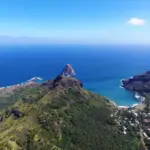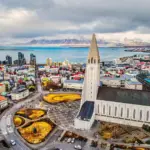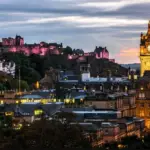
But where is the Dominican RepublicIf you're looking for the perfect travel destination, the Dominican Republic has it all. Located in the Caribbean on the island of Hispaniola, the country is famous for its stunning beaches, majestic mountains, lush waterfalls, and much more. Furthermore, Dominican culture is vibrant and welcoming, with indigenous, African, and European influences blending to create a unique identity.
If you are looking for a unforgettable experience, don't miss the chance to visit the Dominican Republic and explore its charms in person.
Main Conclusions:
- The Dominican Republic is a charming destination, known for its stunning beaches and vibrant culture.
- THE country is located in the Caribbean, on the island of Hispaniola, and borders the Atlantic Ocean and the Caribbean Sea.
- Santo Domingo is the capital of the Dominican Republic, with a fascinating mix of colonial history and modernity.
- Dominican cuisine is a blend of flavors and influences, with delicious dishes worth trying.
- The Dominican Republic offers a wide range of tourist attractions, from luxury resorts to water activities and ecotourism.
Geographical location of the Dominican Republic
The Dominican Republic is a island country Located in the Caribbean, on the island of Hispaniola, which is shared with Haiti. It borders the Atlantic Ocean to the north and the Caribbean Sea to the south.
The island of Hispaniola is the second bigger Caribbean island with a total area of 76,192 km². The Haitian part of the island is located west of the Dominican Republic. The capital and largest city of the Dominican Republic is Santo Domingo, located on the south coast of the island.
The Dominican Republic is a tourist destination popular for its stunning beaches, tropical climate, beautiful natural landscapes and rich history and culture.
Capitals of the Dominican Republic
The Dominican Republic has one main city and capital of the country, which is Santo Domingo. The city is the largest and oldest capital of the Americas, having been founded in 1496 by Christopher Columbus's brother, Bartholomew Columbus. Santo Domingo is located on the southern coast of the island of Hispaniola, bathed by the Caribbean Sea.
Besides being the political and administrative capital, Santo Domingo is also the country's economic and cultural center. It's a city steeped in colonial history, boasting many monuments and ancient buildings, as well as a lively nightlife and numerous shopping and dining options.
Other capitals of the Dominican Republic
Besides Santo Domingo, the Dominican Republic has other capitals: Santiago, San Pedro de Macorís, and La Romana. Santiago is the country's second-largest city, known as the "Heart City" due to its privileged geographical location. San Pedro de Macorís is the capital of the province of the same name, known as "Sugar City" for its sugar production. La Romana, the capital of the province of the same name, is famous for its luxury resorts, golf courses, and Saona Island.

Natural beauty of the Dominican Republic
The Dominican Republic is a destination that enchants everyone with its natural beauty, especially its stunning beaches. With over 1,500 km of coastline, the island offers some of the most sought-after beach destinations in the world.
Among the most famous beaches is Punta Cana, known for its white sand and turquoise waters, as well as its wide selection of luxury resorts. Bávaro Beach, also in Punta Cana, is another popular option, as is Juanillo Beach, considered one of the most beautiful in the region.
In addition to beaches, the Dominican Republic offers a wide variety of natural beauty. For example, the Samaná region, in the northeast of the country, is famous for its rivers, waterfalls, and mountains. National park Los Haitises, with its caves, mangroves, and rock formations, is another must-see tourist spot.
Visitors can also enjoy outdoor activities such as hiking, mountain biking, and boating, as well as exploring the country's marine life through diving and snorkeling. Without a doubt, the Dominican Republic is a destination that offers endless possibilities for nature and outdoor activity lovers.
Dominican history and culture
The Dominican Republic has a rich and fascinating history, influenced by a blend of indigenous, African, and European traditions. From the arrival of the Spanish in the late 15th century to the struggle for independence in the 19th century, the country has undergone many changes and challenges over the years.
Dominican culture is a diverse and vibrant blend of African, indigenous, and European influences. music and dance are an important part of Dominican life and culture. Merengue is the national rhythm and can be heard everywhere, while bachata is a popular form of music and dance throughout the country.
Dominican cuisine is a blend of flavors and influences, with dishes that combine meat, vegetables, and rice. Sancocho, a stew made with various types of meat, is a national dish and can be found in many restaurants throughout the country. Additionally, there are many dishes based on fresh seafood, including shrimp, lobster, and crab.
The fight for independence
THE history of the Dominican Republic includes a struggle for independence that began in 1821. In 1838, the country was formally established as an independent nation. The history of the struggle for independence is commemorated every February, during Independence Month, with parades and festivities throughout the country.
African influence on Dominican culture
Dominican culture was significantly influenced by the presence African in the country, especially during the slavery era. Afro-Caribbean music and dance, such as merengue and bachata, are examples of African influence on Dominican culture.
“Dominican culture is a diverse and vibrant blend of African, indigenous, and European influences.”
Religion is also an important part of Dominican culture, with many Dominicans following the Catholic religion or practicing Santeria, an Afro-Caribbean religion.
Art and literature are other forms of cultural expression in the Dominican Republic. The country has a rich literary tradition, with authors such as Julia Alvarez and Junot Diaz gaining international recognition. Dominican folk art is known for its vibrant colors and folkloric themes.
Dominican Cuisine: Try the delicious typical dishes of the Dominican Republic
Dominican Republic cuisine is a blend of indigenous, African, and European influences, resulting in a variety of unique flavors and aromas.
A very popular dish in the country is the famous rice and beans, served at almost every meal. Roast pork is another delight of Dominican cuisine, as is mofongo, a dish made with fried plantains stuffed with meat or seafood.
Sancocho is a stew made with beef or chicken, vegetables, and plantains, much loved by locals. Also worth noting are the fresh tropical fruit juices and delicious desserts, such as coconut pudding and breadfruit baked with honey.
If you're a fan of fish and seafood, try Dominican ceviche, made with white fish, onion, cilantro, and lime juice. For spicy food lovers, picapollo is a great option, consisting of fried chicken with a spicy seasoning.
The Dominican Republic's culinary options are vast and varied, catering to all palates. Be sure to try these delicious traditional dishes during your visit.

Tourism in the Dominican Republic
The Dominican Republic is a tourist destination A standout in the Caribbean, with a variety of options for visitors. In addition to its stunning beaches, the country offers many activities and sights to enjoy.
Tourist Attractions
The main tourist attractions in the Dominican Republic include:
- White sand beaches and crystal clear waters, such as in Punta Cana, La Romana, Samaná and Puerto Plata.
- Luxury resorts, boutique hotels, and budget accommodation options.
- Water activities such as diving and snorkeling, boating and fishing.
- Ecotourism, with visits to waterfalls, mountains and national parks, such as National park The Haitians.
- Historical tours, with visits to places such as the colonial city of Santo Domingo, the first capital of the New World.
- Lively nightlife, with bars, restaurants and clubs.
With so many options, it's easy to find something for every type of traveler in the Dominican Republic.
Tips for visiting the Dominican Republic
If you're planning a trip to the Dominican Republic, here are some helpful tips to ensure your trip is enjoyable and hassle-free.
Required documents
To enter the Dominican Republic, you'll need a valid passport and a return ticket to your home country. Depending on your nationality, you may need a visa. Be sure to check the entry requirements before embarking on your trip.
Climate
The Dominican Republic has a tropical climate with an average temperature of 28°C year-round. The rainy season occurs between May and October, so it's advisable to bring light clothing and an umbrella. The dry season is from December to April, so it's advisable to bring sunscreen and light clothing.
What to bring
In addition to lightweight clothing and sunscreen, it's a good idea to bring insect repellent, personal medications, comfortable walking shoes, and a backpack to carry your belongings during the day. If you plan on visiting the beaches, don't forget a swimsuit or bikini, towel, and sunglasses.
Health and safety
The Dominican Republic is generally safe for tourists, but it's always advisable to take basic precautions, such as avoiding poorly lit or unfamiliar areas at night, not displaying valuables, and not leaving valuables in your car. It's also important to be aware of the presence of mosquitoes that transmit diseases such as dengue and Zika, and to bring insect repellent.
With these tips in mind, you'll be ready to make the most of your trip to the Dominican Republic.
Accommodation in the Dominican Republic
Finding the perfect place to stay in the Dominican Republic is easy, as the country offers a wide range of options to suit all tastes and budgets.
If you're looking for a luxurious getaway, world-class resorts are available on the country's most coveted beaches, such as Punta Cana, La Romana, and Samaná. These resorts offer everything from elegant rooms to water activities and world-class dining. Additionally, many resorts offer all-inclusive programs, packages, and discounts for extended stays.
If you prefer something more intimate, boutique hotels are available in many cities, including Santo Domingo, which offers some of the best lodging options in the country. These hotels offer an experience more personalized, with tastefully decorated rooms, personalized services and a relaxing atmosphere.
For those looking for a more budget-friendly option, guesthouses, hostels, and rental apartments are available in many of the Dominican Republic's major cities and towns. These accommodations offer an authentic experience at affordable prices, allowing you to save money to explore more of the country.
Regardless of your travel style, the Dominican Republic has the perfect place to stay. Be sure to research and choose the best option for your travel needs.

Conclusion
The Dominican Republic is an incredible destination for those seeking stunning beaches, vibrant culture, and plenty of adventure. With a fascinating history, delicious cuisine, and welcoming people, this Caribbean country has much to offer visitors.
In this article, we explore the geographic location of the Dominican Republic and its capital cities. We also learn about its natural beauty, history and culture, gastronomy, and tourism options. We hope we've helped you plan your next trip to this enchanting country.
Now that you know more about the Dominican Republic, be sure to add it to your travel bucket list. You're sure to be enchanted by everything this incredible country has to offer. Make the most of your visit and enjoy everything the Dominican Republic has to offer!
FAQ
Where exactly is the Dominican Republic?
The Dominican Republic is located in the Caribbean, on the island of Hispaniola, shared with Haiti. It borders the Atlantic Ocean to the north and the Caribbean Sea to the south.
What are the capitals of the Dominican Republic?
The main capital of the Dominican Republic is Santo Domingo, located on the southern coast of the island of Hispaniola.
What are the natural beauties of the Dominican Republic?
The Dominican Republic is known for its stunning beaches, such as Punta Cana and Samaná. Furthermore, country has mountains majestic, lush waterfalls and rich flora and fauna.
What is the history and culture of the Dominican Republic?
The Dominican Republic has a fascinating history, from the arrival of the Spanish to the struggle for independence. Its culture is influenced by indigenous, African, and European traditions, resulting in a vibrant identity.
What are the typical dishes of Dominican cuisine?
Dominican cuisine is a blend of flavors, with highlights including rice and beans, roast pork, mofongo, and sancocho. Fresh tropical fruits and exotic fruit juices are also popular.
What are the tourist attractions in the Dominican Republic?
In addition to beautiful beaches, the Dominican Republic offers luxury resorts, water activities, boat tours, ecotourism, and a vibrant nightlife.
What are some useful tips for visiting the Dominican Republic?
Before traveling, check the necessary documents, know the climate, pack appropriately and be aware of the safety tips and health.
Where to stay in the Dominican Republic?
The Dominican Republic offers a wide variety of accommodation options, from luxury resorts to boutique hotels and budget-friendly options, catering to all tastes and budgets.
Where is the Dominican Republic?
The Dominican Republic is located in the Caribbean, on the island of Hispaniola, shared with Haiti. It borders the Atlantic Ocean to the north and the Caribbean Sea to the south.
Lucas Wanderlust has a tireless spirit of adventure, always seeking new travel experiences. Fascinated by the world and the possibility of exploring unknown destinations, he fell in love with the sense of freedom and self-discovery that traveling alone provides. With a backpack on his back and a heart open to the unknown, Lucas embarks on exciting journeys, where each destination becomes a unique chapter in his life story. He gives himself body and soul to the magic of solo travel, inspiring others to follow in his footsteps and discover themselves through adventure.







